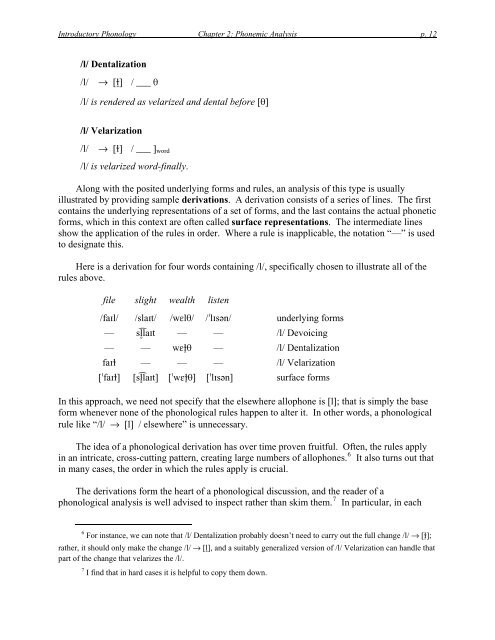Introductory Phonology - UCLA Department of Linguistics
Introductory Phonology - UCLA Department of Linguistics
Introductory Phonology - UCLA Department of Linguistics
Create successful ePaper yourself
Turn your PDF publications into a flip-book with our unique Google optimized e-Paper software.
<strong>Introductory</strong> <strong>Phonology</strong> Chapter 2: Phonemic Analysis p. 12<br />
/l/ Dentalization<br />
/l/ → [ɫ̪] / ___ θ<br />
/l/ is rendered as velarized and dental before [θ]<br />
/l/ Velarization<br />
/l/ → [ɫ] / ___ ]word<br />
/l/ is velarized word-finally.<br />
Along with the posited underlying forms and rules, an analysis <strong>of</strong> this type is usually<br />
illustrated by providing sample derivations. A derivation consists <strong>of</strong> a series <strong>of</strong> lines. The first<br />
contains the underlying representations <strong>of</strong> a set <strong>of</strong> forms, and the last contains the actual phonetic<br />
forms, which in this context are <strong>of</strong>ten called surface representations. The intermediate lines<br />
show the application <strong>of</strong> the rules in order. Where a rule is inapplicable, the notation “—” is used<br />
to designate this.<br />
Here is a derivation for four words containing /l/, specifically chosen to illustrate all <strong>of</strong> the<br />
rules above.<br />
file slight wealth listen<br />
/fal/ /slat/ /wɛlθ/ /ˈlsən/ underlying forms<br />
— sl̥ ͡lat — — /l/ Devoicing<br />
— — wɛɫ̪θ — /l/ Dentalization<br />
faɫ — — — /l/ Velarization<br />
[ˈfaɫ] [sl̥ ͡lat] [ˈwɛɫ̪θ] [ˈlsən] surface forms<br />
In this approach, we need not specify that the elsewhere allophone is [l]; that is simply the base<br />
form whenever none <strong>of</strong> the phonological rules happen to alter it. In other words, a phonological<br />
rule like “/l/ → [l] / elsewhere” is unnecessary.<br />
The idea <strong>of</strong> a phonological derivation has over time proven fruitful. Often, the rules apply<br />
in an intricate, cross-cutting pattern, creating large numbers <strong>of</strong> allophones. 6 It also turns out that<br />
in many cases, the order in which the rules apply is crucial.<br />
The derivations form the heart <strong>of</strong> a phonological discussion, and the reader <strong>of</strong> a<br />
phonological analysis is well advised to inspect rather than skim them. 7 In particular, in each<br />
6<br />
For instance, we can note that /l/ Dentalization probably doesn’t need to carry out the full change /l/ → [ɫ̪];<br />
rather, it should only make the change /l/ → [l̪], and a suitably generalized version <strong>of</strong> /l/ Velarization can handle that<br />
part <strong>of</strong> the change that velarizes the /l/.<br />
7 I find that in hard cases it is helpful to copy them down.

















